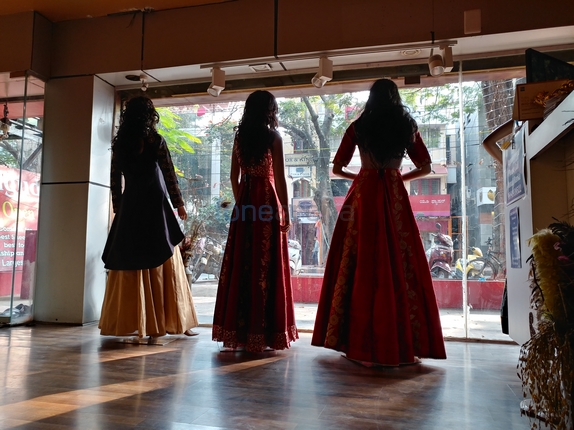
The LG V series is to the G series what the Galaxy Note series is to the Galaxy S series. However instead of being more of an upgrade or an updated version of the G series, the V series phones have an entirely different personality to themselves. The V10 in fact was without a doubt, one of the best smartphones of 2015. It borrowed many of the specifications and features from the G4 but it fixed almost everything that was wrong with the G4 and then bundled some more unique features into a fresh design. The V10 till this day remains one of the best smartphones on the market and the only real issue that people faced was being able to buy one.
Unboxing
Here are the contents of the box:
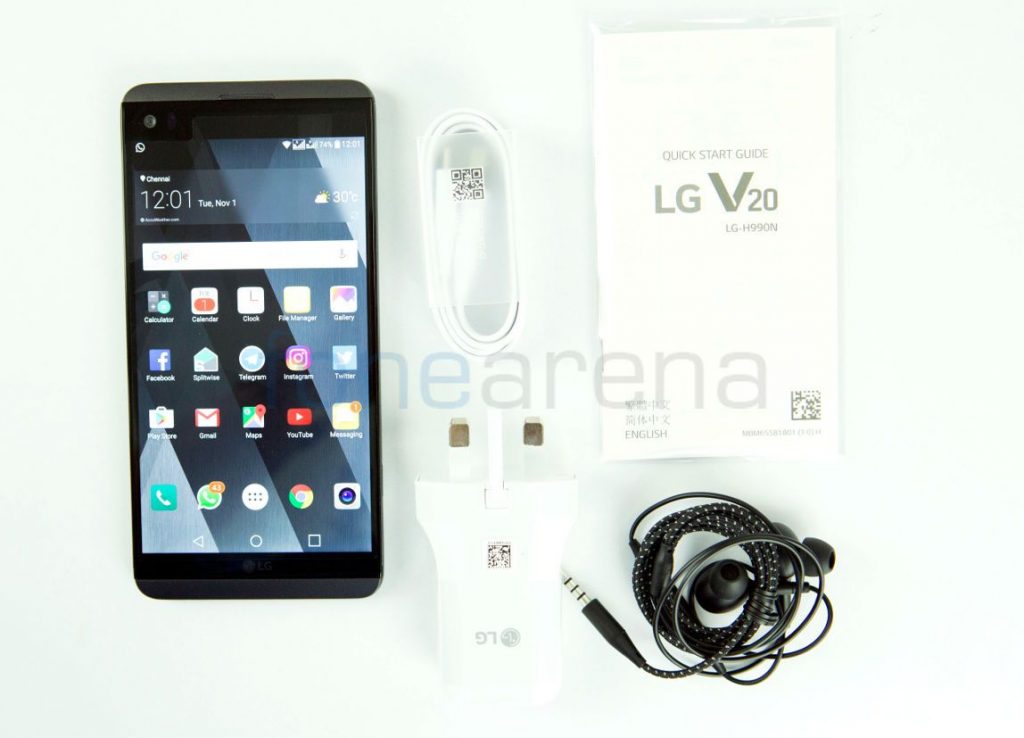
- LG V20 smartphone in Titan color
- B&O PLAY In-ear headphones with nylon braided cable
- 3-pin fast charger (9V-1.8A/5V-1.8A)
- USB Type-A to USB Type-C tangle-free flat cable
- Quick start guide
Design, Materials and Build Quality
Unlike the V10 which featured a dramatically different design compared to the LG G4, the V20 actually does borrow some traits from its smaller sibling – the G5. In fact, it seems like a Hybrid between the V10 and G5, combining the best of both worlds. The most noticeable difference or omission from the G5 is the lack of modular support but that is good in my opinion since LG’s vision of a modular concept was flawed in more ways than one. I won’t be wasting time going down that path again right now.

It borrows a similar shape and size from the V10 since this too has a largely rectangular design with rounded corners instead of the pebble like design of the G5. The V20 however unlike its predecessor comes in a metal body with a Gunmetal grey sort of finish. V10 had a metal frame but the front was plastic and the back was this unique silicon like material that was quite durable; thus giving it a MIL 810G rating for protection against shocks and drops. The V20 also holds onto that certification but doesn’t have the same silicon like material for the back panel. Not a major bummer since the back panel is still removable and there is a large button on the right side of the phone towards the bottom that allows you to remove the backplate. This release mechanism is better than the plastic tabs that are used to snap the back cover in place.

The backplate is made of AL-6013 aluminium which is most commonly used for ABS brakes and aircrafts for its high strength and anti-corrosive nature. So it definitely ticks all the right boxes for durability. The only non-metal portions on this phone are at the top and bottom. Although, the caps at the top and bottom feel like plastic, they are made of polycarbonate which is more durable than plastic especially when it comes to impacts. The reason behind having these caps is to facilitate for better reception (cellular and wireless).
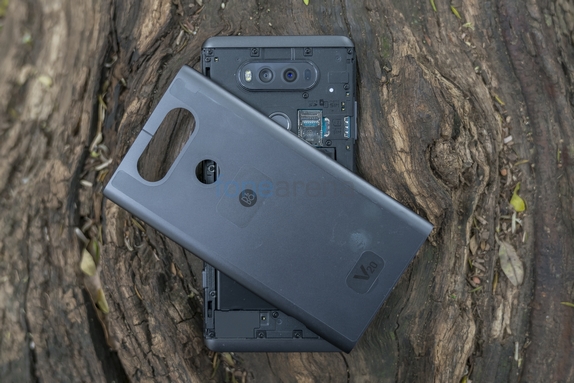
The backplate is pretty durable but isn’t entirely scratch proof so we’d still advise you to avoid putting it along with your keys or coins and other sharp material or metals. The battery on the phone is removable and you also get access to the microSD card slot and nanoSIM slot (Dual NanoSIM on Dual SIM variants). The removable battery and microSD expansion are somewhat of a rarity these days especially the former, so it is definitely a welcome addition considering that even Samsung took away the removable battery from the Note series which was considered to be a boon for several power users.
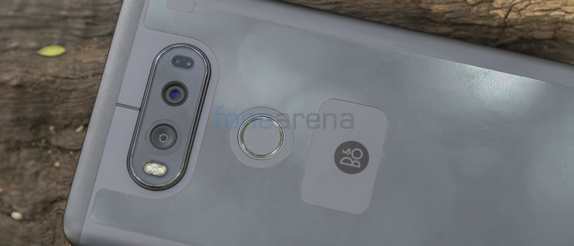
The V20 is actually surpisingly light for its size. It looks heavier than it actually is and a lot of it can be attributed to the use of Aluminium. The V10 weighed around 192 grams but the V20 weighs in at 174 grams and is actually carrying a beefier battery. The V20 also has good weight distribution while the V10 was a bit more top-heavy in comparison.
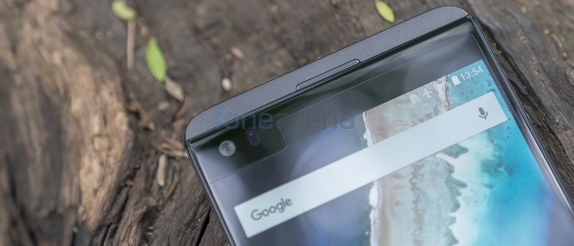
Build quality is really solid and it actually feels a lot more premium than the LG G5 which we felt had a pretty weird finish and seemed more like a prototype than a final build device. The buttons too are sturdy and the camera is protected by scratch resistant sapphire crystal glass which is incredibly difficult to scratch but is a bit brittle compared to regular glass so be careful about dropping it.
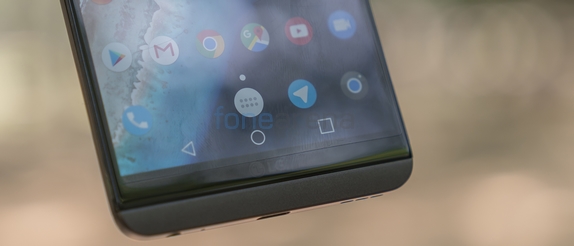
Up front, you have the large 5.7″ display which is housed onto a surface area that is of practically the same height but narrower than the V10 and is even slimmer at 7.6mm. You also get a secondary display above the main one which doesn’t have the same width due to the front facing camera and the sensors occupying the space beside it. Finally, you have the earpiece at the top and a subtle LG logo beneath the display.
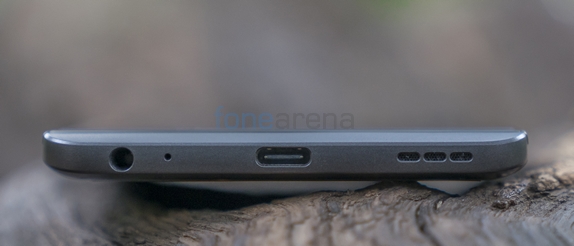
The bottom houses the 3.5mm audio jack, primary microphone, USB type-C port and loudspeaker while you find the secondary microphone as well as IR blaster at the top.
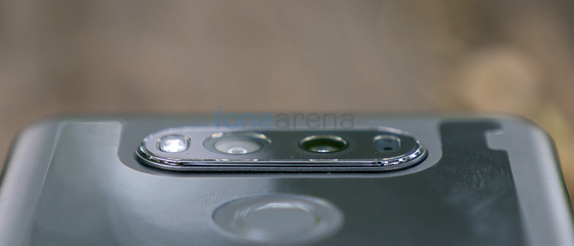
The back side has the camera module which is raised a bit considering that it houses two camera, a dual LED flash and a Laser AF assist module. The module isn’t actually raised all that much however, due to the extra surface area and some bezel enhancements around it, you get the impression that it sticks out like a sore thumb even when it doesn’t.

Below it is the fingerprint sensor, the B&O branding and finally a V20 branding. The V20 is available in 3 colours – Silver, Pink and Titan. The unit we are reviewing is the Titan one which is a dark grey sort of colour and probably the most unique one of the three although the other two should also be able to find an audience.
The V20 is pretty big for a 5.7″ device however, it also has a secondary display above it and that is one of the main reasons for the extra height. Luckily, it isn’t too difficult to handle and a lot of that could be attributed to the good weight distribution. We definitely didn’t feel fatigued using it as a daily driver.
Primary Display
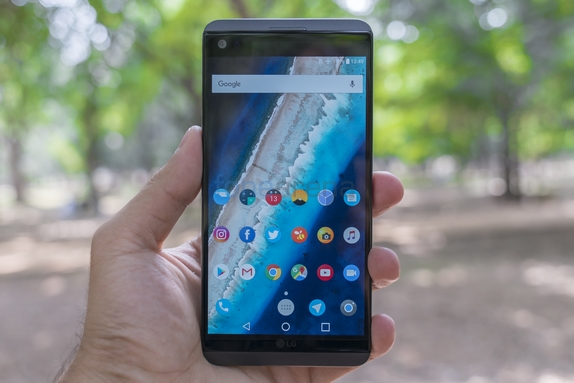
The primary display on the V20 is a 5.7″ IPS display with 1440p resolution. The contrast levels are better than the previous LG flagships and thanks to the high levels of brightness, the sunlight legibility is really good too. The Corning Gorilla Glass 4 is pretty durable against scratches as well but as always, if you are someone who cringes at the sight of even the smallest of scratches, it is definitely better to put some protection on it.
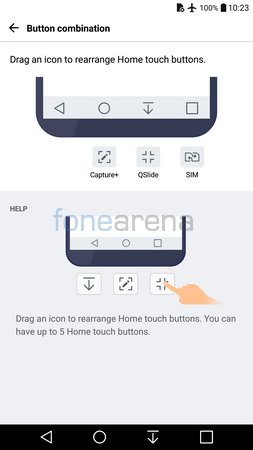
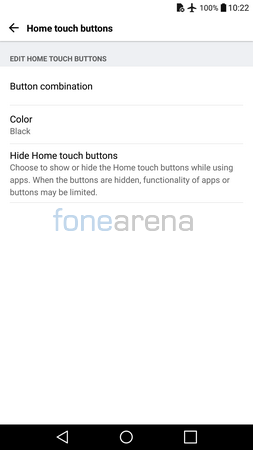
Since the phone relies on on-screen navigation buttons, the UI allows users to customize the positioning as well as the buttons that they wish to have at the bottom of the screen. The default return, home and recent apps buttons can’t be removed but can be rearranged based on your preference. Additonally, you can add a notification drawer toggle, capture+ shortcut, SIM toggle (on DualSIM variants) and a QSlide shortcut. Users can have a maximum of 5 shortcuts on the navigation bar which itself can be in either Black or White. You can even go further and choose whether or not to hide the buttons in certain apps.
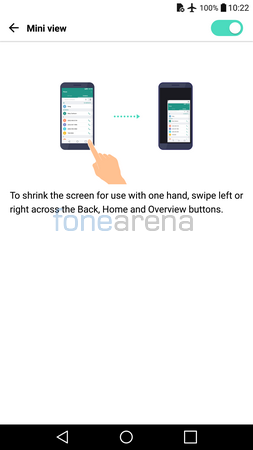
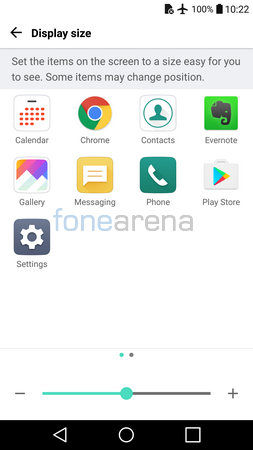
Due to the large display, it is important to help users facilitate single hand usage or to make things more accessible even with two hands. There is a mini view mode that essentially shrinks the entire screen content to one corner of the screen and also a display size mode that allows you to set the size for the icons, settings and other UI elements; be it smaller or bigger which is basically a DPI setting. Users can also enable the KnockON feature to facilitate double tapping the screen to wake the device up or put it to sleep.
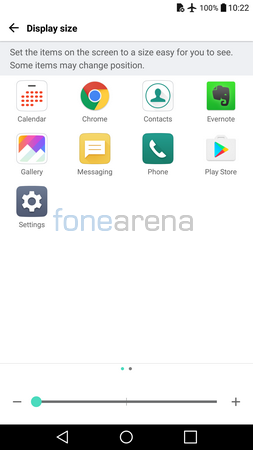
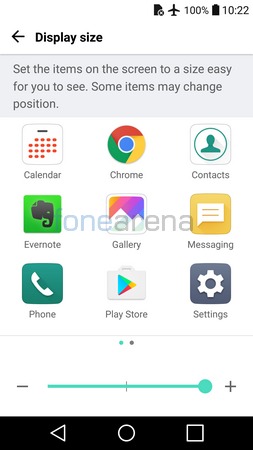
Finally, there is a comfort view mode that reduces the blue light emitted from the screen to prevent eye-strain. Using your phones and computers for long durations especially at night has been proven to cause sleeplessness. There are three different modes available such as Low, Medium and High. With each higher level, the screen gets noticeably more and more yellow since the amount of Blue light keeps reducing at each level. There is also the option of a Black and White mode which cuts down all colours except for Black, White and shades of grey. I personally prefer this since I really can’t stand the yellowish look regardless of how beneficial it is to my health. For all intents and purposes, the Black and White mode brings the same benefits but in a more bearable tone and also improves the battery life by a slight margin in the process.
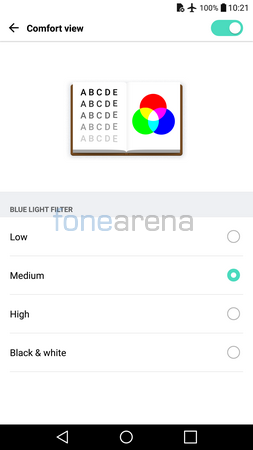
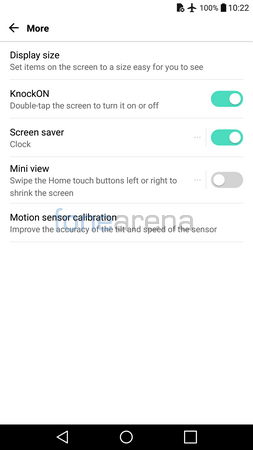
Secondary Display
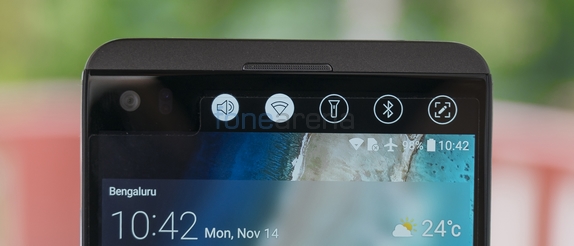
The V20 brings back the secondary display of the V10 with a few upgrades. The screen has a resolution of 160×1040 pixels since it isn’t as wide as the main display. It too is a touchscreen and can be made to turn on when your phone is active or when it is sleeping or during both instances. The main idea behind the secondary display is to help you get quick access to shortcuts and certain controls without disrupting the main screen estate and also to again provide shortcuts and the ability to view notifications without having to wake the phone up often.
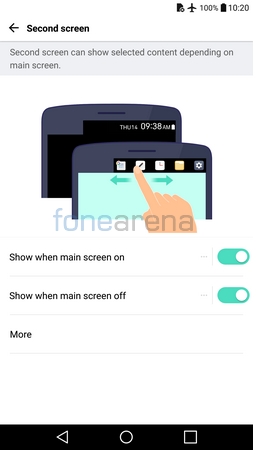

When the phone is sleeping, you can use the secondary screen to view the time, day, date as well as battery percentage. You can use it to toggle the sound profile, the WiFi, Bluetooth, Torch and Capture+ or even control music playback. When the phone is sleeping, the display only works in a monochrome mode but when the phone is awake, you get colourful shortcuts and also the ability to display a signature on the second screen. You can even customize the signature as well as toggles and shortcuts that come on the 2nd display.
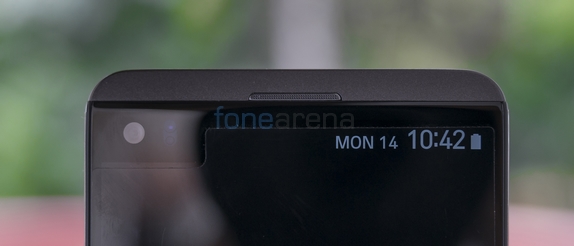
While the second screen is quite useful and a great feature to have for a flagship phone, my main issue with it is the placement. The second screen should ideally be placed below the primary display especially on a large screen phone such as this. Perhaps, it can even be used to house the navigation buttons and a swipe to the left or right will bring about other controls as well. I did hope that LG would take such a route with the V20 but it seems that we may have to wait for the V30 if at all LG does decide to make the switch.
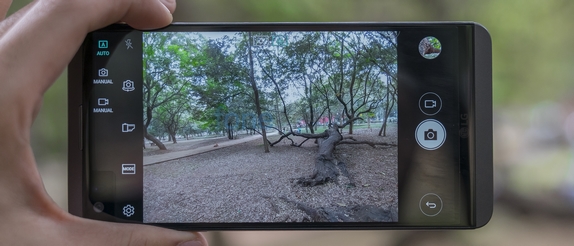
Regardless of whether you have the secondary display switched off totally or not, some apps such as the camera will override your settings and use the secondary display to show some controls such as the modes which in my opinion is a really nice touch and gives you a more un-interrupted view of the viewfinder.
Fingerprint Sensor
One of the biggest issues with the LG V10 and even the LG G5 to a certain extent were their fingerprint scanners. On the V10, it was really flimsy and the accuracy was very poor. While the accuracy was certainly improved on the G5, it too felt flimsy and had a certain play/wobble to it that felt cheap. The V20 has a really solid fingerprint sensor which again doubles up as the lock/power button.
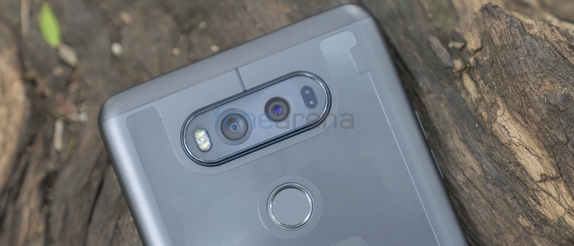
However, this time around, there isn’t volume controls on the back since they have been moved to the left side. One of the downsides of having a rear-mounted fingerprint sensor and power button is that you can’t wake the phone up without lifting it up from the surface. Luckily, the secondary screen helps overcome this to a certain extent and you also have the KnockON feature to wake up the phone and put it to sleep even without pressing the power button.
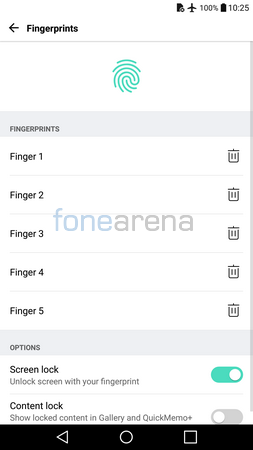
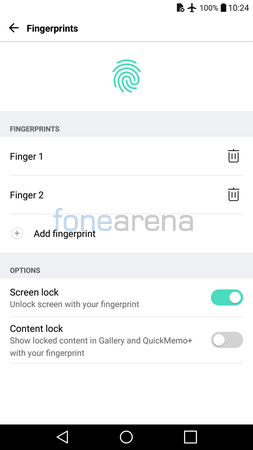
In case you do have the phone in your hands, the fingerprint sensor is always active and just placing your finger on it will unlock the phone directly. There is no need to wake the phone up first before unlocking it even though that is another way to do it. The fingerprint sensor is really accurate now and you can add upto 5 fingerprints. Users can also use their fingerprint for payment authentication or locking content.
Calling and Messaging
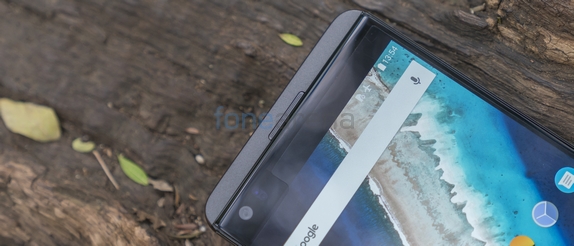
Call quality on the V20 is really good both over the earpiece and the loudspeaker. Volume is more than sufficient on both too although the mono loudspeaker can be a bit underwhelming in certain noisier environments. The phone does support VoLTE as long as your carrier supports it too.
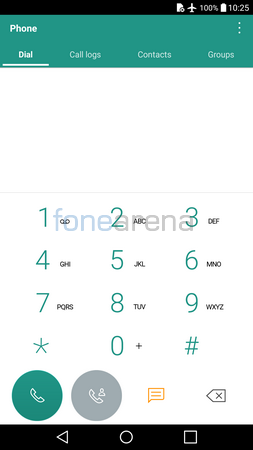
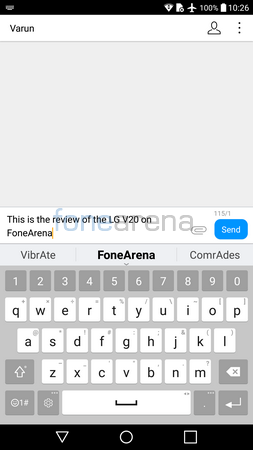
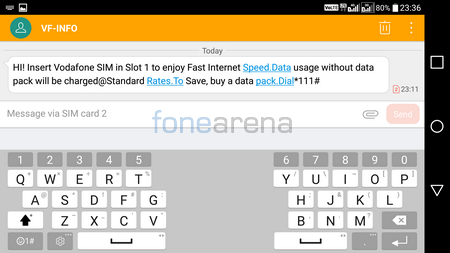
The dialpad is large and intuitive as well as having the ability to quickly choose which SIM to place the call over on the DualSIM model. LG Keyboard is pretty good and offers a good level of customization as well including a number row, split keyboard in landscape mode as well as a one-handed keyboard on portrait mode.
Software and UI
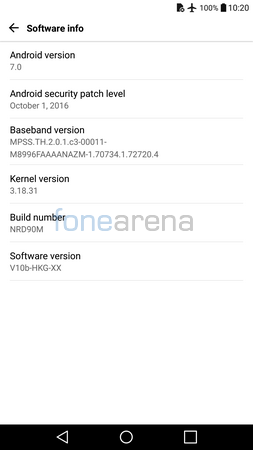
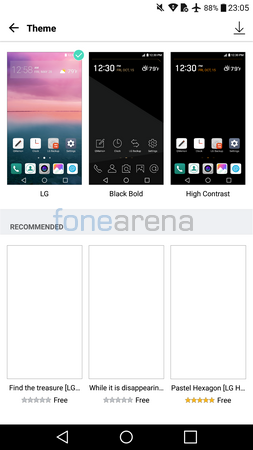
The V20 created a lot of waves before and after its announcement for being the first smartphone to ship with Android 7.0 Nougat out of the box. Normally, the latest smartphone from Google is usually the phone that claims that title but this year LG took the crown. Even though, the new Pixel phones from Google were the first to ship with Android 7.1 out of the box, LG still deserves an applause for it. At the time of writing this review, the V20 was running on Android 7.0 Nougat with the October 2016 security patch level.
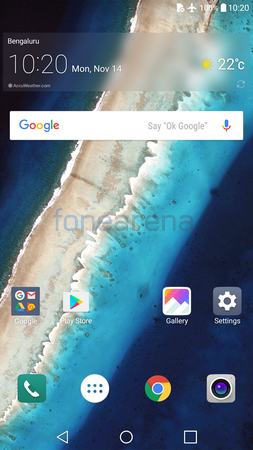




Nougat brings in quite a lot of improvements such as native split-screen multi-tasking which is available in both portrait as well as landscape modes. In portrait mode, the portion of the screen occupied by the two apps is adjustable but is a fixed 50-50 situation in landscape mode.

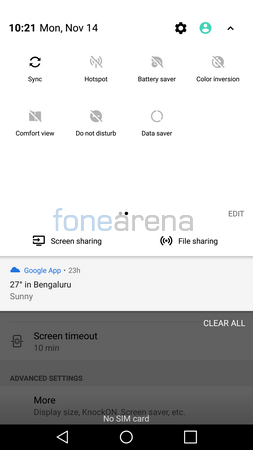
The Doze feature is now even better as well as more intelligent and so are the quick actions as well as the notifications. Updates as well as upgrades will also be much faster on Nougat; allowing users to use their phone while the upgrade and optimization takes place in the background after a much quicker reboot than before.
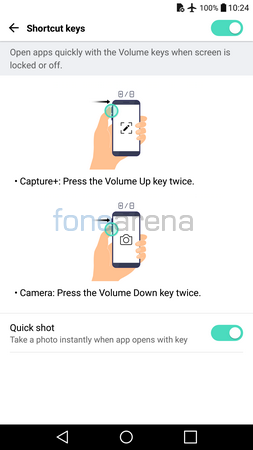
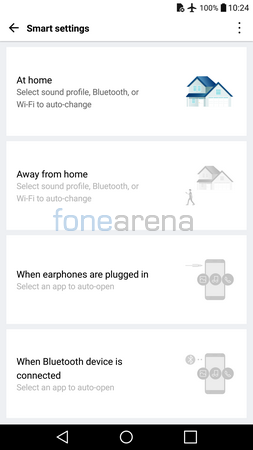
Everything is well in terms of software except for the UI which to be honest looks quite dated and can use a big refresh or two. Samsung have refined and simplified TouchWiz by a big margin that makes it easy to live with but the same can’t be said about LG’s UI. Most users would prefer to install and use a custom launcher. There are two shortcuts as well which you can use to quick launch the camera app and to take launch Capture+.
Storage, Connectivity and Performance
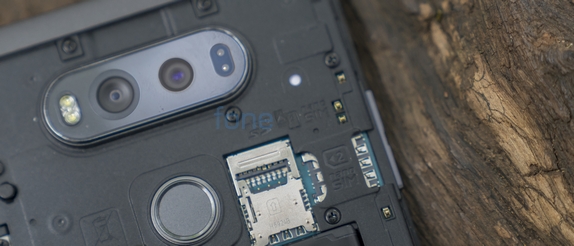
The V20 comes in 2 different storage models – 32GB and 64GB. Both also come with dedicated microSD card slots for expansion and accepts cards upto 256GB in capacity. Since the phone features a removable back cover, it has a traditional SIM tray which means you don’t need a SIM ejector pin to insert or remove the SIM cards. There is a small stub that you can use to slide out your SIM card. The DualSIM variant takes 2 nanoSIMs while the singleSIM variant takes one nanoSIM.


The USB Type-C port is a welcome change over the V10 which was introduced around the time when the port started gaining popularity. The V10 was already probably nearing the end of its development cycle by that time so LG definitely is forgiven for that. The port can take reversible connectors and supports OTG functionality. It also has supports for Dual-Band WiFi 802.11 a/b/g/n/ac, Bluetooth 4.2 and an IR blaster which can be used to control appliances and electronics.
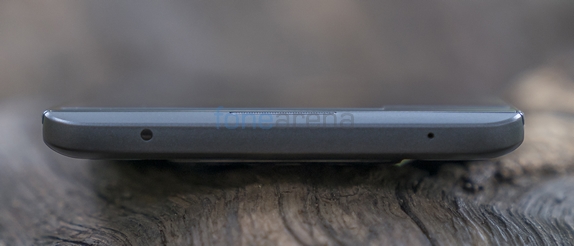
The device is powered by a Snapdragon 820 processor which is one of the best on the market currently performance wise but many have argued that LG could’ve put in a Snapdragon 821 if they wanted to. Perhaps that is true but the V20 is still a solid performer with 4GB of RAM and an Adreno 530 GPU. Gaming is pretty good too but many reports have popped up in relation to lag during gaming but that is mostly because many of them have forgotten to switch off the game battery saver mode which especially takes a toll on heavier games. Turning this off from the battery settings will make sure that your gaming experience is better and more fluid.
Camera
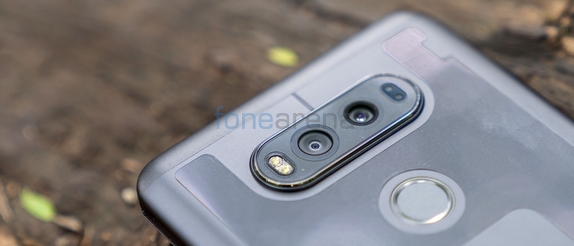
The rear camera module on the V20 is pretty much the same as the one found on the G5. Users get two different cameras at the back along with a dual LED flash and Laser Autofocus. The primary difference here however is on the software front and like the V10, the V20 comes with the most extensive stock camera UI of any smartphone on the market.
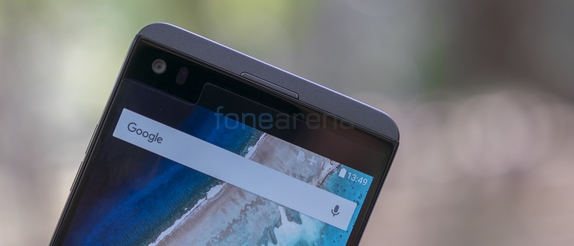
The first camera is a 16 Megapixel unit with 29mm focal length, OIS and f1.8 aperture. The Laser Autofocus only assists the 16 MP camera since the secondary camera is a fixed focus 8 Megapixel one with f2.4 aperture and 12mm focal length. In terms of Field of View, you get 75 degrees and 135 degrees from the 16 MP and 8 MP cameras respectively. The photos above are with the 16 MP camera and the photos below are with the 8 megapixel camera.
The 16 Megapixel camera manages to capture plenty of detail like the G5 and LG flagships of the recent past. The dynamic range is good too and the colours as well as sharpness are on point. The OIS works really well and is much better than the implementation by Samsung for example for photos but the S7 series has a large aperture and sensor size going for it so the V20 needs this. HDR photos are quite good in terms of dynamic range but they do take a bit longer to be captured. Luckily, like we mentioned earlier, the OIS works really well at mitigating the effects of a slow shutter such as shakes. The dynamic range and processing aren’t as good as the Pixel XL for example but is still one of the best on the market alongside the S7 series. Below are some samples with the 16 MP f1.8 camera.
The 8 Megapixel camera too captured good detail and even though it isn’t quite as sharp or loaded with detail as the 16 MP one, it produces some really stunning photos and interesting compositions thanks to the extremely wide FoV. The fixed focus is a non-issue too since most of the objects that you will be capturing with this lens will be either landscapes, cityscapes, architecture or large group photos. The f2.4 aperture does seem to be a bit low especially when low light photos are concerned but even then it isn’t as bad as say the iPhone 7 Plus with its f2.8 aperture on the telephoto lens. Below are some photos with the 8 MP f2.4 camera.
Low light performance is pretty good too and noise levels are kept in check.The only issue I have with the still image quality is the excessive noise reduction applied onto photos in auto mode. While this maybe required for the wide-angle camera due to the smaller sensor size and aperture, it most definitely isn’t required for the 16 MP camera. However, it seems like LG is using the same algorithm for both these cameras in auto mode and that is causing the issue and leading the photos to lose out on detail in auto mode. To truly get the benefits and fine details that the impressive camera can capture, we recommend using the RAW capture mode and using the DNG to process the image to your liking without having to lose out on the details.
Despite having only a single front facing camera, LG have somehow pulled off an impressive feat of having both a regular as well as a wide field of view for the V20 front camera. The V10 too had two fields of view for the front camera but it in fact had 2 different cameras up front to do that. Not sure what sort of black magic LG has done but the single camera does effectively produce an 83 degree FoV and 120 degree FoV from the same camera. The 5 Megapixel sensor with f1.9 aperture takes detailed photos that are ideal for both single as well as group self portraits or even video call sessions with multiple people.
The V20 is perhaps the best smartphone on the market for Vloggers considering how versatile it is in terms of video recording. Users get to choose between 2 FoV for the front and rear cameras and they also get a whole bunch of controls on the software front. The V20 like its predecessor, comes with an extensive manual mode not just for photos but for videos as well. This time around, LG have carried over the customization to the acoustic front too. The built-in microphone can be tweaked to capture more sound from the rear of the phone or front, can turn on a wind noise filter, can adjust the gain and several other parameters. Visually, you can choose the resolution, the frame rate, the bit rate and even the aspect ratio (including a 21:9 aspect ratio). Note – the 21:9 aspect ratio is available only in HD or Full HD modes. A UHD 21:9 mode would’ve made this a must have for indie film-makers on a strict budget.
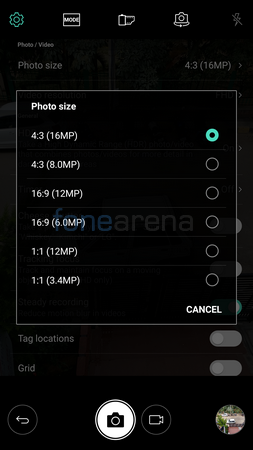
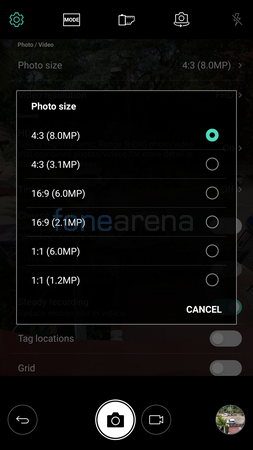
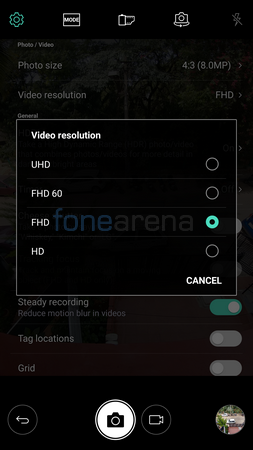
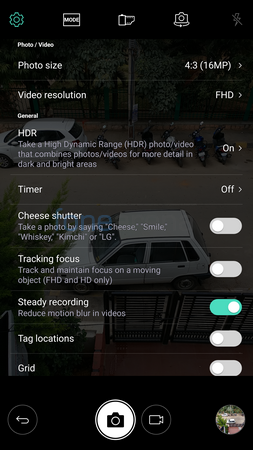
HD and Full HD videos are available in 1, 2, 24, 30 and 60 fps modes with steady recording as well as tracking focus while UHD videos miss out on the 60 fps option as well as steady recording and tracking focus. Users can also choose to enable HiFi audio recording in all resolutions but you need compatible apps to play the high quality sound in full detail. We recommend you turn this on for the best experience since the V20 can capture up to 132 decibel of sound without any distortion. Aside from that, photos and videos support manual selection of White Balance, Focus, Exposure, ISO, shutter speeds and you can even lock the exposure.
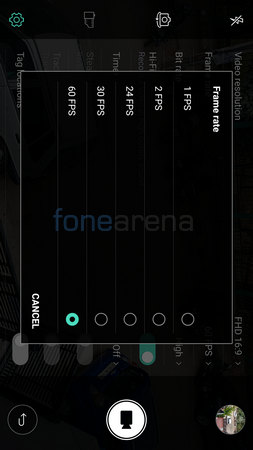
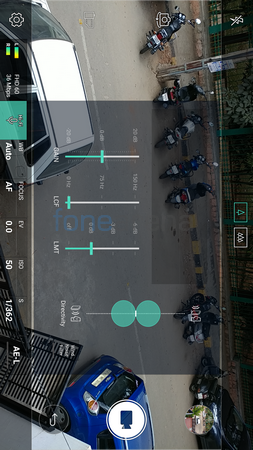
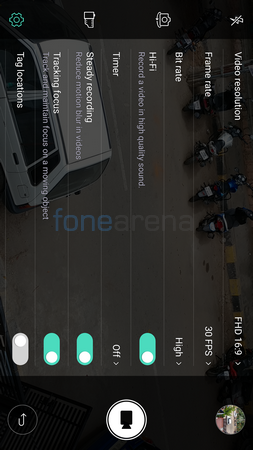
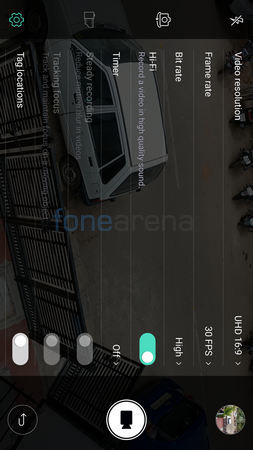
Music
The audio quality on the LG V20 is nothing short of brilliant. Thanks to a built-in 32bit DAC and B&O Play (bang and Olufsen Play), the V20 has an amazing audio quality and not to mention is capable of incredibly high volume levels over headphones or earphones. In fact, it wouldn’t be recommended to play the content onto to your ears at full volume for too long as it may cause damage. The audio quality is really good and the dynamic range is excellent. You do really need to get some lossless audio onto your phone to truly appreciate the output. The loudspeaker too is pretty loud however, it is mono and that is the only sad part about the audio experience. The noise is incredibly low through earphones and you really need a high quality pair of earphones to truly take advantage of the DAC. Luckily, LG has included a high quality B&O Play earphone with the V20.
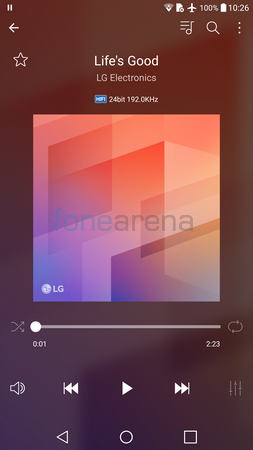
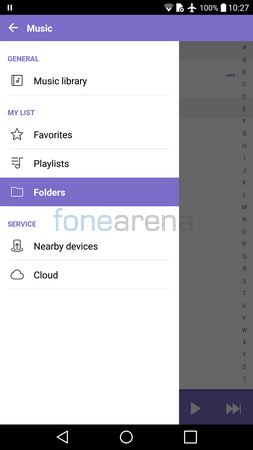
The music player is fairly simple in terms of visuals however, it comes with support for formats such as FLAC, ALAC, WAV, MP3 etc. There is a built-in equalizer but is limited to certain formats and it support HiFi sound. The phone can even selective use just one of the 4 DACs to play music in case you are using a lower quality earphone. This will help to save some battery as well.
Battery Life
The LG V20 comes with a 3200 mAh removable battery. The fact that its removable itself should be good enough for most people not to worry about battery life. However, I am a firm believer in the fact that there is no true replacement for battery life. Fast charging, removable batteries, wireless charging and any other new technology is great and works well as add-ons but is hardly a good enough replacement for proper battery life.
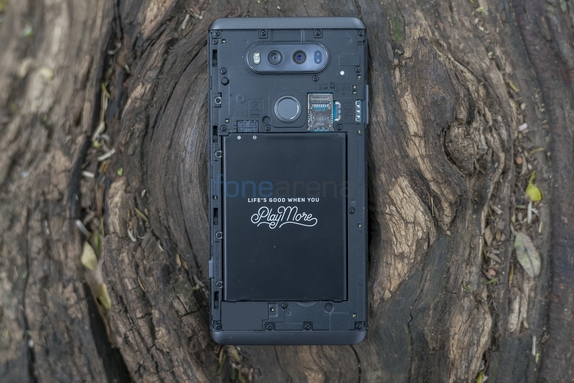
The battery life on the V20 is good but not great. I got around 4 to 4 and a half hours of screen on time using the DualSIM slots. On a single sim, the usage did touch 5 hours on occasion but not always. With the secondary screen turned on along with the primary screen, the battery life doesn’t get affected that much. But with an always on secondary display, the battery life does get affected more.
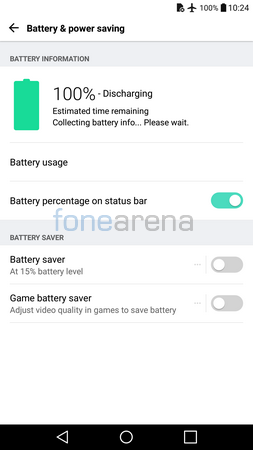
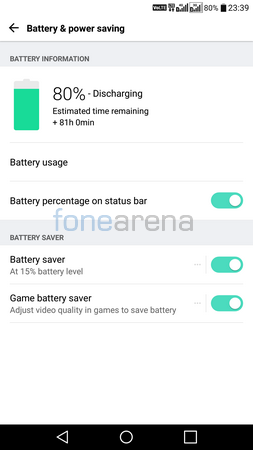
Luckily, the battery is removable and LG also sells battery charging cradles separately that allow users to charge and carry a separate battery just in case the first one dies down. So essentially, you can have around 8 to 9 hours of screen on time in your pocket which should be good enough for even the heaviest of users. Not the ideal battery life but still is better than having to wait for your phone to charge up, no matter how fast the charging times are.
The battery charging cradle too comes with a USB Type-C port so you can use your default charger to charge it up and there is a built-in indicator as well for the charge status. If you are someone who doesn’t mind waiting a bit and prefers to stick with a single battery, then you get fast charging which is QuickCharge 3.0 compliant and you need a QC3.0 compatible charger to be able to charge the phone at its fastest speed.
Conclusion
The LG V20 is without a doubt one of the best offerings on the market when it comes to focus on the camera and multimedia department. The dual camera setup at the rear, dual FoV front camera, extensive manual controls for video/photo and brilliant audio output are all very unique and something that very few smartphones can boast of. Even if they do have one or two of those features, not all can claim to have all of them in one package.
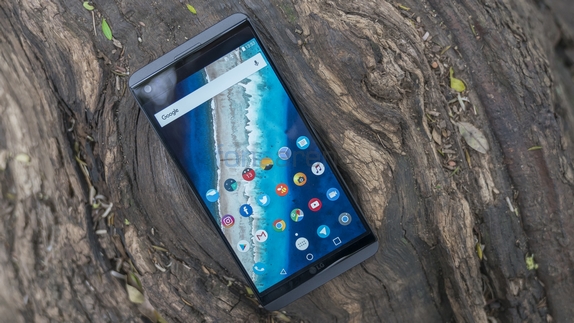
The LG V20 is also one of the best phablet offerings on the market considering that the Note7 is no longer there to compete with. However, LG seems to have failed to capitalize on that and as if delaying the release of the V20 wasn’t enough, the smartphone is still not available everywhere and even in India, its arrival remains quite uncertain despite some high level execs indicating that the smartphone would make its way to India unlike the V10.
Pros
- Great Build Quality
- Good Screen
- Brilliant Audio Quality
- High Quality Dual Camera Setup
- Dual FOV Front Facing Cameras
- Extensive Manual Mode for Camera (Photo and Video)
Cons
- Excessive Noise Reduction on Photos in Auto Mode
- User Interface needs a Re-haul
- Secondary Screen Could’ve been Placed Better





